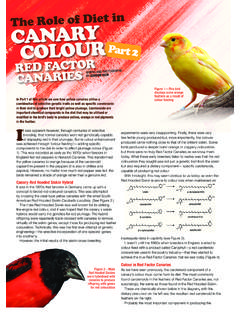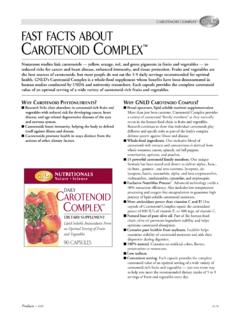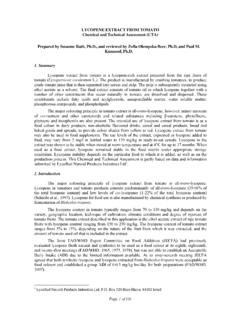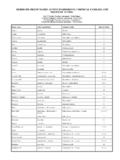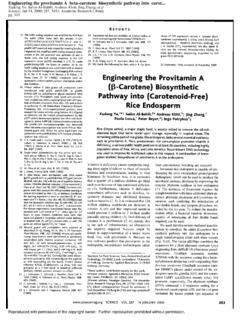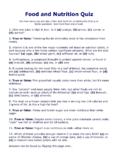Transcription of FT:510 FOOD CHEMISTRY - index - The Feingold Diet
1 FT:510 . food CHEMISTRY . Submitted by: Kiran naz O7-arid-64. FT;6th semester Submitted to:- Dr. Asif Ahmed Topic of assignment:- CHEMISTRY OF food COLORS . CHEMISTRY of food colors food color:- ' food color is any substance that is added to food or drink to change its color.''. food coloring is used both in commercial food production and in domestic cooking. Due to its safety and general availability, food coloring is also used in a variety of non- food applications, for example in home craft projects and educational settings etc Purpose of food coloring:- People associate certain colors with certain flavors, and the color of food can influence the perceived flavor in anything from candy to wine.
2 For this reason, food manufacturers add dyes to their products. Sometimes the aim is to simulate a color that is perceived by the consumer as natural, such as adding red coloring to glace cherries (which would otherwise be beige), but sometimes it is for effect, like the green ketchup that Heinz launched in 2000. While most consumers are aware that food with bright or unnatural colors (such as the green ketchup, or children's cereals such as Froot Loops) likely contain food coloring, far fewer people know that seemingly "natural" foods such as oranges and salmon are sometimes also dyed to mask natural variations in color.
3 Color variation in foods throughout the seasons and the effects of processing and storage often make color addition commercially advantageous to maintain the color expected or preferred by the consumer. Some of the primary reasons include Offsetting color loss due to light, air, extremes of temperature, moisture, and storage conditions. Masking natural variations in color. Enhancing naturally occurring colors. Providing identity to foods. Protecting flavors and vitamins from damage by light. Decorative or artistic purposes such as cake icing.
4 Regulation:- food colorings are tested for safety by various bodies around the world and sometimes different bodies have different views on food color safety. In the United States, FD&C numbers (which generally indicates that the FDA has approved the colorant for use in foods, drugs and cosmetics) are given to approved synthetic food dyes that do not exist in nature, while in the European Union, E numbers are used for all additives, both synthetic and natural, that are approved in food applications. Most other countries have their own regulations and list of food colors which can be used in various applications, including maximum daily intake limits.
5 Natural colors are not required to be tested by a number of regulatory bodies throughout the world, including the United States FDA. The FDA lists "color additives exempt from certification" for food in subpart A of the Code of Federal Regulations - Title 21 Part 73. However, this list contains substances which may have synthetic origins There are 26 colors permitted to be used in food and 28 to be used in cosmetics and pharmaceuticals. There are major three categories of food colors;. 1) Natural colors 2) Synthetic colors 3) Lakes and dyes Natural food Color:- Natural food Color is any dye, pigment or any other substance obtained from vegetable, animal, mineral, or source capable of coloring food drug, cosmetic or any part of human body, colors come from variety of sources such as seeds, fruits, vegetables, algae & insect.
6 A growing number of natural food dyes are being commercially produced, partly due to consumer concerns surrounding synthetic dyes. Some examples include: Caramel coloring (E150), made from caramelized sugar, used in cola products and also in cosmetics. Annatto (E160b), a reddish-orange dye made from the seed of the Achiote. A green dye made from chlorella algae (chlorophyll, E140). Cochineal (E120), a red dye derived from the cochineal insect, Dactylopius coccus. Betanin extracted from beets. Turmeric (curcuminoids, E100). Saffron (carotenoids, E160a).
7 Paprika (E160c). Elderberry juice To ensure reproducibility, the colored components of these substances are often provided in highly purified form, and for increased stability and convenience, they can be formulated in suitable carrier materials (solid and liquids). According to the application a suitable Natural Color can be achieved by keeping in mind the factors such as PH. heat, light storage and the other ingredients of the formula or recipe. The storage conditions for natural colors depend on the particular need of the product. A tight sealed container is best to store he product in a cool storage to preserve color strength and quality, along with its degree of cooling point.
8 Here is a list of few natural food colors:- NATURAL COLOUR EEC NO. DESCRIPTION. Annatto E160b Liquid/Powder (os). LIQUID / POWDER (WS). Turmeric E100 Paste, 35% Curcumin Liquid (Os) Up To 12% Curcumin Liquid (Ws) Up To 10% Curcumin Powder, Up To 95% Curcumin COCHINEAL E 120 Powder, 50% Carminic Acid Carmini Powder, 30% - 95% Carminic Acid Powder Up To 40% Carminic Acid Liquid (Ws) 2% - 10% Carminic Acid Paprika E 160c Liquid (Os) 10,000 To 1,60,000 Cu Liquid (Ws) 10,000 To 50,000 Cu Powder, Spray Dried Anthocyanins E 163 Liquid / Powder (Ws).
9 Liquid / Powder (Ws). Liquid / Powder (Ws). Beta Carotenes E 160a Powder (Ws) Up To Mix Carotenes Carotenoids Liquid (Os) Up To Mix Carotenes Gardenia - Liquid (Ws). Gardenia - Liquid (Ws). Gardenia - Liquid (Ws). Iron Oxides E 172 Powder Iron Oxides E 172 Powder Iron Oxides E 172 Powder Iron Oxides E 172 Powder Marigold Extract E 161b Paste (Os) Up To 10% Xanthophylls Lutein Powder Up To 50% Lutein Chlorophyll E 140 Liquid Ws / Os E 141 Liquid Ws / Os - Powder Ws Titanium Dioxide E 172 Powder & Paste Ws & Od Carbon Black E 153 Powder, Paste, Emulsion In Oil Beet Root E 162 Liquid / Powder (Ws).
10 Safflower - Liquid / Powder (Ws). Caramel E 150 Liquid / Powder (Ws). a,b,c,d Lycopene E 160d 0s .2 To 20%. Monascus - Liquid / Powder (Ws). Red Cabbage - Powder Raddish - Powder Detail of few major colors:- ANNATTO:- Annatto, also called Roucou, is a derivative of the achiote trees of tropical regions of the Americas, used to produce a red food coloring and also as a flavoring. Its scent is described as "slightly peppery with a hint of nutmeg" and flavor as "slightly sweet and peppery". Annatto is produced from the reddish pulp which surrounds the seed of the achiote (Bixa orellana L.)

